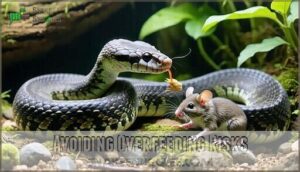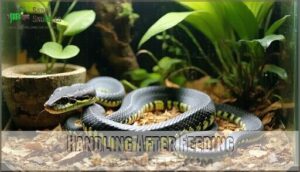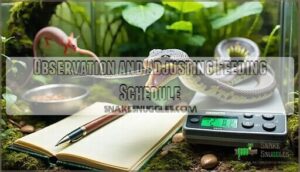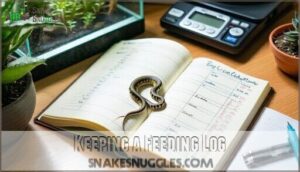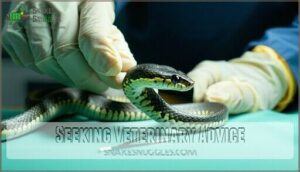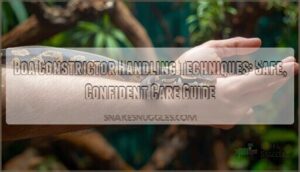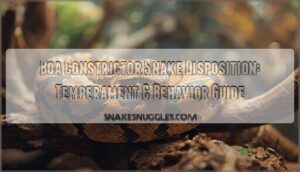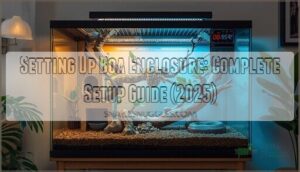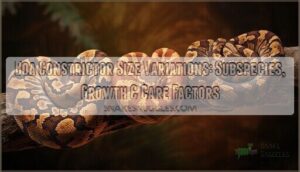This site is supported by our readers. We may earn a commission, at no cost to you, if you purchase through links.
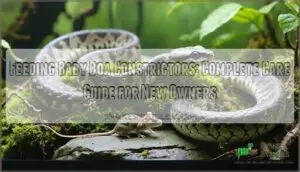 Feeding baby boa constrictors isn’t rocket science, but timing matters more than you’d think.
Feeding baby boa constrictors isn’t rocket science, but timing matters more than you’d think.
You’ll feed juveniles once weekly with appropriately-sized frozen-thawed rodents—think "no bigger than the thickest part of your snake’s body" as your golden rule.
Unlike your teenager who raids the fridge nonstop, baby boas won’t overeat if you stick to this schedule.
They’re naturally programmed to regulate their appetite, so don’t worry about turning them into couch potatoes.
The key lies in consistent scheduling and proper prey sizing, which keeps their metabolism humming along perfectly.
However, several critical factors can make or break your feeding success.
Table Of Contents
- Key Takeaways
- Feeding Frequency for Baby Boas
- How to Determine Prey Size
- Avoiding Overfeeding Risks
- Preparing and Thawing Frozen Rodents
- Handling After Feeding
- Observation and Adjusting Feeding Schedule
- Keeping a Feeding Log
- Seeking Veterinary Advice
- Frequently Asked Questions (FAQs)
- How to take care of baby boas?
- How often should boas be fed?
- What do boa constrictors eat for kids?
- Can baby boas eat insects occasionally?
- Does the type of rodent matter?
- Can a baby boa eat bird chicks?
- Should I feed my boa in the tank?
- What is a good hide for post-feeding?
- What temperature should the feeding environment be?
- How to transition from pinkie to fuzzy mice?
- Conclusion
Key Takeaways
- Feed weekly with properly sized prey – You’ll offer frozen-thawed rodents once a week, ensuring the prey’s width matches your boa’s thickest body section and doesn’t exceed 10% of their total weight.
- Wait 48-72 hours after feeding before handling – You cannot handle your baby boa immediately after meals, since this prevents regurgitation and allows proper digestion to occur without stress.
- Monitor growth through detailed record-keeping – You’ll track feeding dates, prey sizes, weight changes, and behavioral patterns to adjust schedules and spot potential health issues early.
- Stick to consistent schedules but watch for individual needs – You should maintain regular weekly feedings for the first six months, then gradually extend intervals as your boa matures, adjusting based on their appetite and body condition rather than rigid timelines.
Feeding Frequency for Baby Boas
Getting your baby boa constrictor‘s feeding frequency right is like finding the perfect rhythm—it sets the foundation for healthy growth. Weekly feeding works best for most juveniles, giving them consistent nutrition without overwhelming their digestive system.
**Finding the right feeding rhythm for your baby boa creates the foundation for lifelong health and steady growth.
Neonate schedules should start simple: offer food every 5-7 days for the first six months. As your snake grows, you’ll gradually extend meal spacing to every 10-14 days by adulthood. Think of it as their metabolism naturally slowing down with age.
Consistent routines help you spot changes in appetite or behavior. During growth spurts, some babies might seem hungrier than usual—that’s normal. Others might refuse a meal occasionally, which isn’t cause for panic given their slow metabolism.
Pay attention to your snake’s body condition rather than sticking rigidly to a calendar. Feeding intervals should flex based on individual needs, seasonal changes, and your boa’s natural appetite cues. It’s vital to monitor for a healthy boa body shape to guarantee they’re neither underfed nor overfed.
How to Determine Prey Size
Now that you’ve established your baby boa’s feeding schedule, selecting the right prey size becomes your next priority. Think of prey width as your golden rule – it should match your snake’s thickest body section, typically found mid-body.
When your newborn boa swallows appropriate-sized pinky mice, you’ll notice a slight body bulge that disappears within hours.
Key sizing principles for baby boa constrictors:
✔ Prey diameter: Should equal the widest part of your boa’s body
✔ Weight ratio: Prey shouldn’t exceed 10% of your snake’s total weight
✔ Body bulge: A barely visible lump indicates perfect snake food size
✔ Prey shape: Stick with natural rodent proportions, avoiding elongated prey
As your boa grows, gradual shifts between prey sizes prevent digestive stress. It’s important to understand how to determine prey size to avoid health issues.
Some larger juveniles may eventually require multiple prey items, but newborn boas thrive on single, appropriately-sized meals.
- Pro tip: Your boa’s comfort during swallowing tells you everything about proper sizing
- Watch for this: Excessive struggling or regurgitation signals oversized prey
Avoiding Overfeeding Risks
Picture your baby boa constrictor as a growing athlete who needs just the right fuel, not a bottomless buffet. Overfeeding risks plague many new owners who mistake bigger meals for better care. Baby boa constrictors develop fatty deposits when you consistently offer oversized meals, leading to serious health complications down the road.
Feed your baby boa like a coach feeds an athlete—with precision, not excess.
Power feeding – cramming your snake with frequent, large meals – creates a ticking time bomb of obesity-related problems. You’ll recognize a healthy boa by its square body shape with a slightly grooved back. When that back rounds out like a sausage, you’ve crossed into dangerous territory.
Regular weighing becomes your best friend for obesity prevention. Check your boa’s weight weekly and adjust accordingly. Remember, snake food size should match your boa’s girth, not your ambitions. Prey size that’s too large forces unnatural growth patterns, disrupting your boa constrictor growth timeline and potentially shortening their lifespan.
As they’re carnivorous, boas require whole prey nutrition to thrive.
Preparing and Thawing Frozen Rodents
Proper preparation of frozen rodents starts with safe thawing methods. Remove frozen mice from the freezer and submerge them in warm water between 98-100°F for 15-30 minutes.
Temperature control prevents bacteria growth while ensuring complete thawing. Never use hot water or microwaves, as improper thawing can harm your boa’s digestion.
Refrigerator thawing minimizes bacterial growth. Check rodent quality by feeling for consistent warmth throughout.
Use tongs for safe handling during feeding preparation of the rodent, avoiding direct contact that transfers your scent to the prey, ensuring a successful feeding experience with your boa’s digestion and proper temperature control.
Handling After Feeding
When you’ve just fed your baby boa constrictor, patience becomes your best friend. You’ll need to resist the urge to handle your snake for at least 48-72 hours after feeding. This waiting period isn’t just a suggestion—it’s essential for preventing regurgitation risks and supporting proper snake digestion process.
During this time, your boa’s body works overtime to process its meal. Handling them too soon can lead to stress and aggression, negatively impacting their well-being. Any enclosure disturbance or premature handling can trigger stress responses that interfere with digestive health. Think of it like trying to digest Thanksgiving dinner while running a marathon—it simply doesn’t work well.
Create a calm environment by minimizing noise and avoiding unnecessary cage maintenance. Your snake needs this quiet time for ideal digestion monitoring.
- Golden rule: Wait a minimum of 48 hours before any handling duration begins
Watch for signs of digestive complications like unusual behavior or visible discomfort. Proper feeding techniques include respecting your baby boa constrictors’ need for undisturbed rest after meals, ensuring stress reduction and healthy development.
Observation and Adjusting Feeding Schedule
After each feeding session, weight monitoring becomes your best friend for tracking your boa’s health.
Watch for behavior changes like increased activity or lethargy, which signal feeding schedule adjustments are needed.
Environmental factors like temperature shifts affect metabolism, while shedding impact temporarily reduces appetite.
Your feeding observations should focus on hunting responses and body condition.
Growth rate patterns help determine when feeding adjustments are necessary.
Document these feeding behavior changes to maintain ideal health through consistent feeding log maintenance and responsive care.
Seasonal adjustments may be necessary, allowing for longer intervals between meals during cooler months.
Keeping a Feeding Log
Data Tracking becomes your secret weapon when raising baby boa constrictors. A thorough feeding log transforms guesswork into precision, helping you master your snake’s care routine. Record feeding dates, prey size, and your boa’s weight after each meal. This Weight Monitoring system reveals growth patterns that might otherwise go unnoticed.
Your feeding chart should include Shedding Records since appetite often decreases before molting. Note any Behavior Changes like refusing food or unusual activity levels. These details provide Veterinary Insights when problems arise, giving your vet concrete data instead of vague observations.
Think of your feeding schedule as a roadmap. When you track how your baby boa responds to different prey size options, you’ll spot trends quickly. Did she grow faster with weekly feedings? Does she prefer smaller, more frequent meals? Your log holds these answers, making you a more confident keeper. Remember to consult a snake feeding schedule for general guidelines.
Seeking Veterinary Advice
While keeping detailed feeding logs helps track patterns, sometimes you’ll need professional guidance. When to consult a reptile veterinarian includes persistent feeding refusal beyond two weeks, respiratory symptoms like wheezing, or emergency signs such as regurgitation and lethargy.
**Specialist needed?
Absolutely, when dealing with baby boa constrictors** showing unusual behavior. A balanced diet including essential vitamin D3 is also vital for their well-being.
Expert opinions on snake health provide preventative care that catches problems early. Reptile specialists understand feeding baby snakes nuances better than general vets, ensuring your veterinary advice addresses species-specific needs effectively.
Frequently Asked Questions (FAQs)
How to take care of baby boas?
Baby boas need your undivided attention.
You’ll feed them weekly, maintain 80-85°F temperatures, provide secure hiding spots, guarantee proper humidity levels.
And handle them gently after they’ve settled into their new environment, which is crucial for their well-being and requires undivided attention.
How often should boas be fed?
Your boa’s feeding schedule depends on age.
Juveniles need meals weekly, while adults eat every 10-14 days.
As they mature, you’ll stretch intervals longer—mature boas might only need food every 2-4 weeks.
What do boa constrictors eat for kids?
Young boa constrictors eat frozen-thawed rodents like pinkie mice, gradually progressing to larger prey as they grow.
You’ll feed newborns weekly, adjusting prey size to match your snake’s thickest body section.
Can baby boas eat insects occasionally?
Like trying to feed a tiger a salad, offering insects to baby boas won’t work.
These strict carnivores need whole prey like pinkie mice from day one.
Their digestive systems can’t process insects properly.
Does the type of rodent matter?
The specific rodent type doesn’t matter much – mice, rats, and chicks all work well.
What’s key is choosing the right size prey that matches your snake’s girth for safe, healthy feeding.
Can a baby boa eat bird chicks?
While it’s theoretically possible, you shouldn’t feed bird chicks to baby boas.
Their diet naturally includes 40% birds, but frozen-thawed rodents are safer, more nutritious, and eliminate injury risks from live prey.
Should I feed my boa in the tank?
You can feed your boa in its tank without issues.
Use feeding tongs to present prey safely, avoiding hand-feeding.
This method reduces stress from tank transfers and mimics natural feeding behavior.
What is a good hide for post-feeding?
Think of it as your boa’s private sanctuary after dinner.
You’ll want a snug, dark hide box that’s slightly larger than your snake’s coiled body, providing secure walls for peaceful digestion.
What temperature should the feeding environment be?
You’ll want to maintain your boa’s enclosure at 78-88°F during feeding time.
This temperature range keeps their metabolism active for proper digestion while ensuring they’re comfortable enough to strike and consume prey effectively, which is crucial for their overall health and digestion.
How to transition from pinkie to fuzzy mice?
Baby boas typically double their weight within six months, signaling it’s time to upgrade meals.
You’ll switch when your snake’s thickest body section equals a fuzzy mouse’s width, ensuring proper digestion and healthy growth rates.
Conclusion
Mastering feeding baby boa constrictors transforms from intimidating puzzle to routine success when you follow these fundamentals.
Weekly feeding schedules, proper prey sizing, and careful observation create the foundation for healthy growth.
Remember, consistency beats perfection—your snake won’t suffer from minor schedule adjustments, but dramatic changes can stress their system.
Keep detailed records, trust your observations, and don’t hesitate to consult experienced keepers or veterinarians when questions arise.
Your dedication guarantees thriving, well-fed boas, and it’s essential to have a healthy growth plan in place, ensuring you’re providing the best possible care with proper prey sizing.
- https://dubiaroaches.com/blogs/snake-care/boa-constrictor-care-sheet?srsltid=AfmBOori2e6Nq3RaZpwye4nHa8JbL8ZeCr7BjT1RHJc08EPBaOL386bD
- https://www.corhs.org/uploaded/20110110-222726_Guide%20to%20Caring%20for%20Boa%20Constrictors.pdf
- https://oddlycutepets.com/how-often-to-feed-boa-constrictors/
- https://reptifiles.com/boa-constrictor-care/what-do-boa-constrictors-eat/
- https://www.animalsathome.ca/boa-constrictor-feeding-chart/

